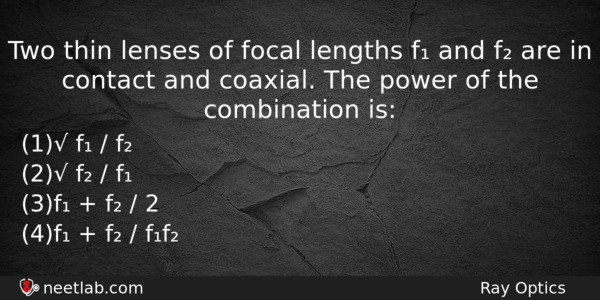| ⇦ | 
| ⇨ |
Two thin lenses of focal lengths f₁ and f₂ are in contact and coaxial. The power of the combination is:
Options
(a) √ f₁ / f₂
(b) √ f₂ / f₁
(c) f₁ + f₂ / 2
(d) f₁ + f₂ / f₁f₂
Correct Answer:
f₁ + f₂ / f₁f₂
Explanation:
The focal length of the combination
1/f = 1/f₁ + 1/f₂
Power of the combinations,
P = f₁ + f₂ / f₁ f₂ ( P = 1 / f )
Related Questions: - A hollow sphere of charge does not produce an electric field at any
- Identify the paramagnetic substance
- A source of sound S emitting waves of frequency 100 Hz and an observer
- If a solid sphere of mass 1 kg and radius 0.1 m rolls without slipping at a uniform
- In a region, the potential is represented by V(x,y,z)=6x-8xy-8y+6yz, where V
Topics: Ray Optics
(94)
Subject: Physics
(2479)
Important MCQs Based on Medical Entrance Examinations To Improve Your NEET Score
- A hollow sphere of charge does not produce an electric field at any
- Identify the paramagnetic substance
- A source of sound S emitting waves of frequency 100 Hz and an observer
- If a solid sphere of mass 1 kg and radius 0.1 m rolls without slipping at a uniform
- In a region, the potential is represented by V(x,y,z)=6x-8xy-8y+6yz, where V
Topics: Ray Optics (94)
Subject: Physics (2479)
Important MCQs Based on Medical Entrance Examinations To Improve Your NEET Score
18000+ students are using NEETLab to improve their score. What about you?
Solve Previous Year MCQs, Mock Tests, Topicwise Practice Tests, Identify Weak Topics, Formula Flash cards and much more is available in NEETLab Android App to improve your NEET score.
Share this page with your friends

Leave a Reply